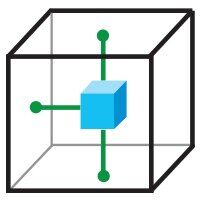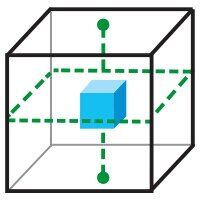Product Info
How To Choose The Right Laser For Your Job
We'll dive into each type of laser and for which applications each is most commonly used. We'll also outline a few key products offered by DEWALT for each category.

Choosing the right laser can be hard. With such a wide offering, how do you know which one to choose for your job? In this article, we’ll dive into each type of laser and for which applications each is most commonly used. We’ll also outline a few key products offered by DEWALT for each category.
LINE LASERS:
Let’s begin with the most common laser found on a jobsite, the line laser. A line laser projects an accurate horizontal or vertical illuminated line onto the surface at which the laser is pointed. Use line lasers indoors when installing cabinetry, tile, a drop ceiling, or for basic leveling. They can also be used outdoors when framing or installing a deck.

There are two types of projections, a forward projection and a 360 projection. The forward projection does just what it sounds like, it projects a line directly onto the surface where the laser is pointed. Similarly, the 360 projection will project a line 360 degrees surrounding the laser. For example, when using a line laser in a room, the forward projection would provide you with a line on one wall whereas the 360 would project that line on all four walls of the room.
Line lasers are offered with a red beam or a green beam. A green beam is easier to see with the human eye because the green wavelength is larger than red. Green is also more visible in sunlight, so it is easier to see outside. When it comes to the visibility range, it depends on the lighting conditions. In dim, dusk-like conditions, it is possible to see a green beam for over 100 feet. One thing to keep in mind is that green beams do require more battery power than red beam lasers.
DEWALT offers these lasers on a 12V MAX* battery platform as well as with Alkaline batteries. Plus, our line lasers offer an integrated magnetic bracket to make them easy to mount during use. Suggested SKUs include our 12V MAX* 3 X 360 Green Line Laser (DW089LG) and our Green Cross Line Laser (DW088CG).
SPOT LASERS:
Spot lasers differ from line lasers in that they project a small circle of light onto the surface your laser is focused on. They are intended for transferring points from one surface to another. This could be for making sure a joist or wall is plumb (vertical) or to ensure pipes traveling from floor to floor are plumb. Spot lasers are most commonly used for plumbing installation, electrical work, HVAC, and framing applications.

DEWALT offers spot lasers in both 3-spot and 5-spot. A 3-spot provides plumb and forward-facing dots whereas the 5-spot adds a right and left dot for transfer of points from wall to wall. A suggested SKU is our Green Beam 3 Spot Laser (DW083CG) with a high-visibility green beam. This laser includes a single lever power switch that locks the pendulum in the off position, as well as a built-in magnetic pivoting bracket to easily mount the laser onto metal surfaces.

COMBINATION LASERS:
Combination lasers project both lines and spots simultaneously or independently. These lasers are great for professionals who complete a wide range of projects as they allow the user to switch between lines, spots, or both depending on the job at hand. Electricians and plumbers will find these lasers to be extremely helpful for countless applications such as installing lighting, outlets, running wires, and pipes.

DEWALT offers combination lasers in both red and green variations. Our newest combination lasers are offered in the 12V MAX* system and include 2-spot cross and 5-spot cross models. A suggested SKU is our 12V MAX* 5 Spot + Cross Line Green Laser. This laser includes an integrated bracket to easily mount onto metal surfaces. It also offers a 165-foot range with a detector for the line, and a 150-foot range for the spot.
ROTARY LASERS:
Rotary lasers are used to kick off nearly every professional construction job. Their applications range from grade work (digging foundations), to layout and masonry. Both dual-slope and single-slope rotary lasers are used to continue a desired pitch across a large area. The desired pitch might be level for finding grade or when using a reference line. Dual-slope means that the line will move along both the X axis and Y axis. X mode is used often to “walk” the line in vertical mode for aligning metal track. Y is used to angle the line in horizontal mode for setting slope or setting pitch on a driveway.

From an accuracy standpoint, DEWALT offers a rotary laser that works up to 2,200 feet with an accuracy of 1/16 inch at 100 feet. This laser is the 20V MAX* Tool Connect™ Green Tough Rotary Laser (DW080LGS). This rotary laser is extremely durable with the ability to withstand up to a 6-foot drop, and an IP67 rating for water and dust protection. Connect it to the Tool Connect™ app via Bluetooth® technology for features including tool tracking, bump notifications, fall and drop indications, and changes in slope and line detection.
LINE AND ROTARY DETECTORS:
There are 2 types of detectors used in the construction industry: Line and Rotary. Since line lasers and rotary lasers work on different wavelengths, they require specific detectors. The detectors are also color-specific. This means a red line laser requires a red line detector. For both rotary lasers and line lasers, detectors are not a requirement, but they do come in handy when the beam is no longer visible. For DEWALT, the standard visibility range on our line laser levels is 50 to 100 feet. While using the detector that range is extended out to 165 feet. Rotary laser detectors allow for detection up to 2,200 feet with the DW079 and DW080 series.
GRADE RODS:
Grade rods are used in conjunction with rotary lasers for digging or leveling earth. You must move the detector up or down on the grade rod while the rotary is spinning until you identify the laser line. When that laser line is found you have then established “grade” or level. If you are looking to dig a hole that is 3 inches deep, for example, you would move the detector 3 inches up the grade rod. After you dig 3 inches down and place the grade rod in the hole, you should hear a beep and read that the laser is hitting the detector. This is verification that you have dug the 3 inches deep.
BOTTOM LINE
As you can see, DEWALT offers a robust line of lasers including spot, line, combination, and rotary, as well as laser accessories to go with them. With the professional in mind, we will continue to evolve and innovate these products to accommodate needs on the jobsite. Keep checking back to see what new products DEWALT has to offer.
DISCLAIMERS:
*With respect to 12V MAX* - Maximum initial battery voltage (measured without a workload) is 12 volts. Nominal voltage is 10.8.
**With respect to 20V MAX* - Maximum initial battery voltage (measured without a workload) is 20 volts. Nominal voltage is 18.
The Bluetooth® word mark and logos are registered trademarks owned by the Bluetooth SIG, Inc. and any use of such marks by DEWALT is under license.



